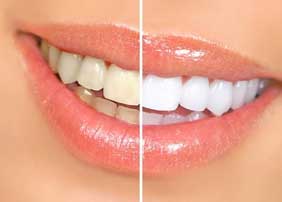 Have you ever wondered if the claims about certain sugar-free chewing gums are true and can in fact help prevent cavities? And, if so, why? Is it a special type of sugar, like xylitol, or is it from the process of just chewing gum?
There is a lot of research about the benefits of chewing sugar-free gum that shows chewing sugar-free gum for 20 minutes following meals does in fact help with the reduction of cavities. Although many studies do say that xylitol can help in reducing cavities, the largest reason why chewing sugar-free gum can help is because of the role it plays in producing more saliva.
When you chew sugar-free gum, there is no sugar present to be broken down in the mouth so there is no food for the bacteria that causes cavities to eat. The process of chewing gum increases the amount of saliva in your mouth. Saliva plays a huge role in keeping your mouth clean and healthy. By increasing the flow of saliva in your mouth, your teeth become more resistant to cavities by letting all the important ingredients to your saliva, such as calcium and phosphate, bathe your teeth and in turn strengthen tooth enamel.
So, it is true! Chewing sugar-free gum can help reduce your risk for cavities.
If you are able to chew gum and consume artificial sweeteners then remember, everything within moderation and be sure to look for chewing gum that has the ADA Seal of Acceptance on the back.
Have you ever wondered if the claims about certain sugar-free chewing gums are true and can in fact help prevent cavities? And, if so, why? Is it a special type of sugar, like xylitol, or is it from the process of just chewing gum?
There is a lot of research about the benefits of chewing sugar-free gum that shows chewing sugar-free gum for 20 minutes following meals does in fact help with the reduction of cavities. Although many studies do say that xylitol can help in reducing cavities, the largest reason why chewing sugar-free gum can help is because of the role it plays in producing more saliva.
When you chew sugar-free gum, there is no sugar present to be broken down in the mouth so there is no food for the bacteria that causes cavities to eat. The process of chewing gum increases the amount of saliva in your mouth. Saliva plays a huge role in keeping your mouth clean and healthy. By increasing the flow of saliva in your mouth, your teeth become more resistant to cavities by letting all the important ingredients to your saliva, such as calcium and phosphate, bathe your teeth and in turn strengthen tooth enamel.
So, it is true! Chewing sugar-free gum can help reduce your risk for cavities.
If you are able to chew gum and consume artificial sweeteners then remember, everything within moderation and be sure to look for chewing gum that has the ADA Seal of Acceptance on the back.
 In today’s health conscious world, there is an increasing focus on maintaining a healthy mind as well as body. Studies now show just how complex our bodies are and how important daily maintenance is.
One topic that I find very interesting and important is the link between periodontal disease and heart disease. Cardiovascular disease affects more than 80 million people in the United States alone. It can present itself in the form of high blood pressure, heart attacks, angina pectoris, strokes or even heart failure. Periodontal disease, in the dental world is also incredibly prevalent.
Periodontal disease is the chronic inflammation and infection of the gums and surrounding tissues. Periodontal or gum disease can involve gingivitis (the inflammation of the gum tissue) or periodontitis (the loss or recession of bone aroud the teeth).
So what’s the connection?
Recent studies have found that the bacteria and inflammatory proteins that are present in gum disease are associated with an increase of blood vessel wall thickening, which is often found in cardiovascular disease.
The theory is that the bacteria and inflammatory proteins found in the mouths of people with periodontal disease make their way to the blood stream where they begin to affect the cardiovascular system.
How does this effect you?
Having good oral health is something we should all strive for, however, if you are at risk for, or have a family history of cardiovascular disease then you should be even more diligent with your oral hygiene. That means flossing and brushing regularly and seeing your dentist at least every 6 months. If you have periodontal disease be sure to tell your physician as well.]]>
In today’s health conscious world, there is an increasing focus on maintaining a healthy mind as well as body. Studies now show just how complex our bodies are and how important daily maintenance is.
One topic that I find very interesting and important is the link between periodontal disease and heart disease. Cardiovascular disease affects more than 80 million people in the United States alone. It can present itself in the form of high blood pressure, heart attacks, angina pectoris, strokes or even heart failure. Periodontal disease, in the dental world is also incredibly prevalent.
Periodontal disease is the chronic inflammation and infection of the gums and surrounding tissues. Periodontal or gum disease can involve gingivitis (the inflammation of the gum tissue) or periodontitis (the loss or recession of bone aroud the teeth).
So what’s the connection?
Recent studies have found that the bacteria and inflammatory proteins that are present in gum disease are associated with an increase of blood vessel wall thickening, which is often found in cardiovascular disease.
The theory is that the bacteria and inflammatory proteins found in the mouths of people with periodontal disease make their way to the blood stream where they begin to affect the cardiovascular system.
How does this effect you?
Having good oral health is something we should all strive for, however, if you are at risk for, or have a family history of cardiovascular disease then you should be even more diligent with your oral hygiene. That means flossing and brushing regularly and seeing your dentist at least every 6 months. If you have periodontal disease be sure to tell your physician as well.]]>
 Even America’s taste in beauty has changed over the years. In general, we’ve moved away from the windswept and overprocessed looks of the 70’s, 80’s and 90’s as seen with Michelle Pfiefer, Cindy Crawford and Farrah Fawcett, to focus on fresh-faced, more natural looking women like Jennifer Aniston, Jessica Alba and Angelina Jolie.
The New Vs. The Old Standards of Beauty:
Even America’s taste in beauty has changed over the years. In general, we’ve moved away from the windswept and overprocessed looks of the 70’s, 80’s and 90’s as seen with Michelle Pfiefer, Cindy Crawford and Farrah Fawcett, to focus on fresh-faced, more natural looking women like Jennifer Aniston, Jessica Alba and Angelina Jolie.
The New Vs. The Old Standards of Beauty:
- Full natural faces vs. angular faces with high cheekbones
- Round to almond shaped eyes with thicker less arched eyebrows vs. Cat eyes with skinny angular eybrows
- Straight noses with longer bridges vs. perky, ski-slope noses
- Full upper and lower lips vs. angular pouts w/ thinner upper lips and a fuller lower lip
- Natural straight white teeth vs. Bright white ear to ear smile with large uniform flat edged smiles.
 Whitening kiosks usually promise results of achieving “at least four shades lighter in less than an hour.” In order to achieve these promised results in a limited amount of time, a professional strength whitening agent with a high hydrogen peroxide content must be used. At that high concentration, you are at a higher risk of chemical burn of the gums, sensitivy or damage to your teeth.
Whitening procedures should always be done under the supervision of a dentist. Although the people at these kiosks may be wearing white coats, they are far from dental professionals. Usually they are unsupervised technicians working without the consultation of dental professionals.
The way kiosks get around the legal implications of performing this procedure unsupervised is that they instruct the “patient” how to place the bleaching agent on their own teeth, rather than place it them themselves. Since they don’t actually do the procedure themselves, they’re absolved from the legal implications of any negative side effects that may result.
It is Frangella Dental’s recommendation that whitening procedures be performed under a dentist’s supervision in a sterile environment. A dentist assesses each patient on an individual basis and predicts the outcome of treatment and any possible dangers.]]>
Whitening kiosks usually promise results of achieving “at least four shades lighter in less than an hour.” In order to achieve these promised results in a limited amount of time, a professional strength whitening agent with a high hydrogen peroxide content must be used. At that high concentration, you are at a higher risk of chemical burn of the gums, sensitivy or damage to your teeth.
Whitening procedures should always be done under the supervision of a dentist. Although the people at these kiosks may be wearing white coats, they are far from dental professionals. Usually they are unsupervised technicians working without the consultation of dental professionals.
The way kiosks get around the legal implications of performing this procedure unsupervised is that they instruct the “patient” how to place the bleaching agent on their own teeth, rather than place it them themselves. Since they don’t actually do the procedure themselves, they’re absolved from the legal implications of any negative side effects that may result.
It is Frangella Dental’s recommendation that whitening procedures be performed under a dentist’s supervision in a sterile environment. A dentist assesses each patient on an individual basis and predicts the outcome of treatment and any possible dangers.]]>
Frangella Dental
Offering advanced techniques in Cosmetic and General Dentistry in New York City.
200 W. 57th Street, Suite 1405
New York, NY 10019
(212) 245-2888
care@drfrangella.com
